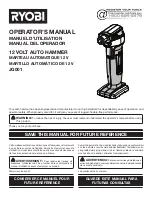
17
Parts & Service: 020 8988 7400 / E-mail: [email protected] or [email protected]
USING THE THICKNESSER
PRECAUTIONS
• Do not try and mill dirty boards, dirt and stones may damage the
blades.
• Remove all nails and staples from the wood before thicknessing.
PREPARING THE WORK
1. The thicknesser works best when the wood has at least one flat surface, use
the planer to create a flat side.
2. If required, rip the wood in half to reduce warping. You can rejoin the
pieces after you have finished milling the wood.
THICKNESSING
1. Start by measuring the thickest part of the board
and adjusting the table
height on the thicknesser to that dimension.
• Note the grain orientation, and be sure to feed the plank into the
machine in the correct direction to avoid tearout.
• Make the first couple of passes with the planned side down on the
table.
NOTE:
To minimize planer snipe, lift the board slightly as it enters the
thicknesser, and again as it comes out.
2. Stay on the infeed side of the machine as you guide the stock through the
machine to support the overhanging end.
3. Once the board is half way through the thicknesser and well supported,
move to the outfeed side and support the opposite end to keep it from
tipping up and into the cutterhead.
4. Raise the table height slightly and repeat until the desired thickness is
reached.
WARNING: ALWAYS WEAR ANSI-APPROVED SAFETY GLASSES OR
GOGGLES WHEN OPERATING EQUIPMENT
CAUTION: DO NOT THICKNESS A BOARD THAT IS LESS THAN 150 MM
LONG. IT IS RECOMMENDED THAT WHEN THICKNESSING SHORT BOARDS
YOU BUTT THEM END TO END TO AVOID KICKBACK AND REDUCE SNIPE.
Summary of Contents for CPT1000
Page 24: ......








































